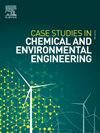Efficient removal of Cd(II) and Pb(II) on NiFeAl-LDH@Polystyrene nanocomposite in single and binary systems: Optimization, kinetic and isotherm studies
Q1 Environmental Science
Case Studies in Chemical and Environmental Engineering
Pub Date : 2025-09-19
DOI:10.1016/j.cscee.2025.101285
引用次数: 0
Abstract
Toxic heavy metals have undesirable consequences for the health of all living things, and their presence in the aquatic environment is a significant concern. In this study, a core-shell nanocomposite (NiFeAl-LDH@Polystyrene(PS)) was synthesized by recycling styrofoam waste with PS:LDH ratios of 2:1 and characterized using (TEM, SEM/EDS, XRD, FTIR, and BET). Then investigate its ability to adsorb Cd+2 and pb+2 ions in single and binary systems. Results showed a hexagonal platelet morphology of NiFeAl-LDH uniformly covered by a shell of PS nanosphers with an average pore diameter of 28.63 nm and a successful adsorption of Cd+2 and pb+2 ions on NiFeAl-LDH@PS. The optimization and influence of adsorption parameters (pH, dosage, agitation speed, initial concentration, and contact time) on the adsorption process were investigated using RSM analysis, yielding a good fit between experimental data and predicted responses with a correlation coefficient (R2) of 0.9956 and 0.9521 for Cd+2 and pb+2, respectively. Adsorption experiments showed that the removal efficiency of Cd+2 and pb+2 in single-component system was 94.42 % and 99.65 %, respectively. While in the binary system, the removal efficiencies of Cd+2 and pb+2 were reduced, indicating that Cd+2 and Pb+2 adsorption was affected by the presence of other metal ion. The Langmuir isotherm model with a maximum capacity of 57.4713 and 177.305 mg/g, for Cd+2 and pb+2, respectively, and the competitive Langmuir model best described the adsorption data in a single-and binary-component system. In a single-component system, it was found that the PSO models accurately described the adsorption, indicating a chemosorption process. Additionally, the modified PSO was used to describe the binary adsorption data on NiFeAl-LDH@PS. Electrostatic force interaction, oxygen-containing functional groups, and complexation reactions controlled the adsorption process. NiAlFe-LDH@PS showed significant reusability as the efficiency was 38.56 % and 42.37 % for Cd+2 and Pb+2, respectively, after six regeneration cycles. In conclusion, NiAlFe-LDH@PS nanocomposite can be considered as an effective adsorbent in the removal of heavy metals from aqueous solutions.

NiFeAl-LDH@Polystyrene纳米复合材料在单、二元体系中高效去除Cd(II)和Pb(II):优化、动力学和等温线研究
有毒重金属对所有生物的健康都有不良后果,它们在水生环境中的存在是一个重大问题。本研究以聚苯乙烯泡沫塑料废料为原料,以聚苯乙烯与LDH的比例为2:1合成了核壳纳米复合材料NiFeAl-LDH@Polystyrene(PS),并利用TEM、SEM/EDS、XRD、FTIR和BET对其进行了表征。然后研究了其在单体系和双体系中吸附Cd+2和pb+2离子的能力。结果表明,NiFeAl-LDH呈六方片状,表面均匀覆盖着PS纳米球壳,平均孔径为28.63 nm,在NiFeAl-LDH@PS上成功吸附了Cd+2和pb+2离子。通过RSM分析考察了pH、投加量、搅拌速度、初始浓度和接触时间对Cd+2和pb+2吸附过程的影响,结果表明,Cd+2和pb+2的实验结果与预测结果吻合较好,相关系数(R2)分别为0.9956和0.9521。吸附实验表明,单组分体系对Cd+2和pb+2的去除率分别为94.42%和99.65%。而在二元体系中,Cd+2和pb+2的去除率降低,说明Cd+2和pb+2的吸附受到其他金属离子的影响。Langmuir等温线模型对Cd+2和pb+2的最大吸附量分别为57.4713和177.305 mg/g, Langmuir模型和竞争Langmuir模型最能描述单组分和二元组分体系的吸附数据。在单组分体系中,发现PSO模型准确地描述了吸附,表明了化学吸附过程。此外,还利用改进后的PSO描述了NiFeAl-LDH@PS上的二元吸附数据。静电力相互作用、含氧官能团和络合反应控制了吸附过程。NiAlFe-LDH@PS在6次再生循环后,Cd+2和Pb+2的再生效率分别为38.56%和42.37%,具有显著的可重复利用性。综上所述,NiAlFe-LDH@PS纳米复合材料可以被认为是一种去除水中重金属的有效吸附剂。
本文章由计算机程序翻译,如有差异,请以英文原文为准。
求助全文
约1分钟内获得全文
求助全文
来源期刊

Case Studies in Chemical and Environmental Engineering
Engineering-Engineering (miscellaneous)
CiteScore
9.20
自引率
0.00%
发文量
103
审稿时长
40 days
 求助内容:
求助内容: 应助结果提醒方式:
应助结果提醒方式:


